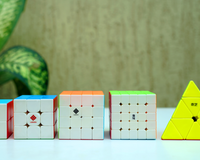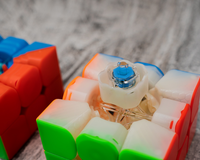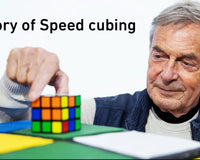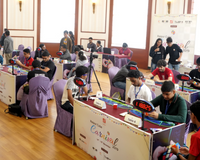CFOP and speedcubing have gained immense popularity over the years, attracting solvers worldwide with the sheer rapidness of the solving process. Solving a Rubik's Cube with that speed requires not only a solid understanding of the fundamentals but also the mastery of various algorithms. In this blog, we'll explore the OLL (Orientation of the Last Layer) algorithms, a crucial step in speedcubing, and delve into effective techniques for mastering them. So, grab your notebook and take some notes!
Understanding OLL

The first step of the two-step last layer solution of the CFOP method, commonly referred to as the OLL, involves orienting all the pieces correctly. Once you've successfully solved the first two layers, you're left with an unsolved top layer. OLL algorithms are used to orient these last layer pieces so that the top face shows a uniform color, which is mostly yellow for white cross solvers. You can significantly reduce solving time by memorizing and executing these algorithms efficiently.
There are 57 standard OLL algorithms, each representing a unique case, depending on the positions and orientations of the pieces. Initially, this might seem overwhelming, but with practice and dedication, you'll be able to internalize these algorithms effortlessly.
Learn full OLL here
Developing a Systematic Learning Approach

To effectively master OLL algorithms, it's essential to follow a systematic learning approach. Here's a step-by-step process that can help you progress efficiently:
- Begin with the Basics: Start by familiarizing yourself with the basic OLL algorithms that appear frequently. These algorithms are relatively straightforward and will lay the foundation for more advanced cases. Practice each algorithm until you can execute them smoothly without hesitation.
- Recognize Patterns: Start observing patterns in the OLL algorithms. By recognizing similarities between different cases, you'll be able to reduce the number of algorithms to memorize. This pattern recognition skill is a game-changer while learning algorithms and will significantly enhance your efficiency.
- Learn Algorithm Families: OLL algorithms can be grouped into families based on their initial orientation of pieces. Instead of memorizing each algorithm individually, focus on learning the algorithms of each family, one by one. This approach enables you to split the daunting 57 algorithms into much smaller sets of algorithms.
- Muscle Memory: Develop muscle memory by repeating the algorithms until they become second nature. This will enhance your execution speed and accuracy.
- Make a calendar: Making a calendar and deciding the days to learn specific algorithms will help in breaking down the 57 algorithms as well. Try to learn 2-3 algorithms a day and not more than that to avoid forgetting the algorithms completely. Drill those algorithms every day and you’ll be finished with OLL algorithms in no time!
Tips for Effective Learning

To make the journey of mastering OLL algorithms more enjoyable and efficient, here are some additional tips to keep in mind:
- Resources: Utilize online resources such as tutorial videos and algorithm databases. These resources provide visual aids and step-by-step instructions, making the learning process more accessible.
- Algorithm Sheets: Create a personalized algorithm sheet with diagrams or notations that you find most intuitive. Having a handy reference guide can be immensely helpful, especially when you're starting out.
- Slow Down to Speed Up: While it may seem counterintuitive, practicing OLL algorithms at a slower pace initially allows you to focus on accuracy and technique. Once you have mastered the algorithms at a slower speed, gradually increase your speed while maintaining control.
- Break It Down: If you find a particular algorithm challenging, break it down into smaller parts. Practice each part individually until you feel comfortable, then combine them to execute the entire algorithm smoothly.
Conclusion
Mastering OLL algorithms is a vital step towards achieving good solving times in speedcubing. These algorithms are perfect if you’re looking to reach an average of sub-15 or sub-12. However, if you’re not even sub-20, I would recommend focusing on other parts of your solve and then learning the OLL algorithms. With a systematic learning approach, dedication, and regular practice, you can learn these algorithms very easily and ingrain them in your muscle memory. Remember to focus on pattern recognition and muscle memory, as these skills will greatly contribute to your speed and efficiency. Enjoy the learning process, stay motivated, and soon you'll impress others with your speedcubing skills!
About Author

Sarthak Masta
Sarthak Masta is a speedcuber from Raipur. He started cubing in 2013 and now has 9 years of cubing experience. Apart from cubing, Sarthak enjoys making music and singing. He has attended a total of 7 competitions in Raipur and has gotten 10 podiums, with 2 gold medals, 4 silver medals and 4 bronze medals.






























